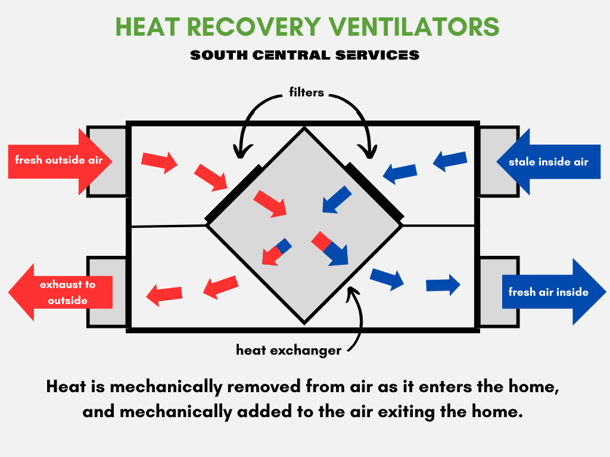The Role of HRV in Eco-Friendly Design
Wiki Article
The All-Inclusive Overview to the Uses of Heat Recovery Ventilation in Modern Structures
Heat Recovery Ventilation (HRV) systems stand for a significant development in constructing technology (HRV Heat Recovery Ventilation). They supply a technique for exchanging stale interior air with fresh outdoor air while decreasing energy loss. This technique not just boosts interior air quality yet likewise contributes to energy efficiency in both domestic and commercial buildings. Comprehending the numerous applications and advantages of HRV can disclose its essential duty in modern-day style and sustainability efforts. The ramifications of this technology deserve exploring even moreUnderstanding Heat Recovery Ventilation Solutions

Lots of modern-day buildings focus on power efficiency, comprehending warmth recovery ventilation (HRV) systems is essential for optimizing indoor air high quality and reducing energy intake. HRV systems work by transferring warmth from stagnant indoor air to incoming fresh air, successfully maintaining comfy interior temperatures while lessening energy loss. These systems contain a heat exchanger, fans, and ductwork that assist in the circulation of air. Throughout winter season, HRV units record and reuse heat from the outbound air, while in summer season, they can help cool incoming air. By continually trading air, HRV systems likewise lower moisture and the focus of indoor contaminants. Correct installment and upkeep of HRV systems are vital for their performance and effectiveness in improving total structure efficiency and convenience.
Advantages of Heat Recovery Ventilation
Heat recovery ventilation systems use many advantages that boost both energy efficiency and interior air top quality in modern structures. By catching and recycling energy from exhaust air, these systems significantly lower heating and air conditioning expenses, resulting in lower power usage. Additionally, they preserve a steady circulation of fresh outdoor air, lessening the danger of interior air pollutants and allergens. This continual exchange assists manage moisture levels, stopping mold and mildew development and making sure a healthier living atmosphere. Additionally, HRV systems add to sustainability objectives by lowering general carbon impacts. Their capability to maximize air flow without giving up thermal convenience makes them a valuable addition to modern building layout, advertising both financial and environmental advantages.Applications of HRV in Residential Structures
As homeowners increasingly focus on energy performance and interior air high quality, the applications of warmth recovery ventilation (HRV) systems in household structures have actually become more prevalent. HRV systems are specifically helpful in securely sealed homes, where maintaining fresh air flow is necessary for avoiding moisture accumulation and interior pollutants. They properly transfer warm from outgoing stale air to inbound fresh air, lowering power expenses associated with heating & cooling. In addition, HRVs can boost comfort degrees by regulating humidity and temperature level. They are additionally adaptable for different property layouts, consisting of single-family homes and multi-unit buildings. In general, integrating HRV systems sustains lasting living techniques while making certain a healthier indoor environment for occupants.HRV in Commercial and Industrial Settings
In industrial and industrial settings, the implementation of heat healing ventilation (HRV) systems has become progressively vital for enhancing energy efficiency and maintaining air quality. These systems effectively move warmth from exhaust air to inbound fresh air, lowering the demand for added home heating or air conditioning. This not only reduces power prices yet additionally adds to sustainability initiatives. Industries such as manufacturing, warehousing, and workplace structures profit considerably from HRV systems, as they assist regulate temperature level and moisture levels, making certain a comfy and efficient environment. Moreover, HRV systems aid in eliminating contaminants and excess wetness, enhancing indoor air high quality. As laws around air high quality become more stringent, the fostering of HRV innovation is most likely to grow, making it an essential element of modern business and industrial infrastructure.Future Patterns in Heat Recovery Ventilation Modern Technology

Often Asked Inquiries
Exactly How Does Heat Recovery Ventilation Influence Indoor Air Top Quality?
Heat recovery ventilation greatly enhances interior air quality by constantly exchanging stale indoor air with fresh exterior air while recouping power. This procedure lowers toxins, keeps ideal humidity levels, and assures a healthier atmosphere for occupants.Can HRV Equipments Be Set Up in Existing Structures?
HRV systems can undoubtedly be installed in existing structures. Retrofitting may require adjustments to ductwork and ventilation designs, but it substantially improves energy efficiency and interior air quality, making it a feasible alternative for older structures.What Upkeep Is Required for HRV Solutions?

Are There Certain Climates Where HRV Is Much More Reliable?
Heat recovery ventilation systems are especially reliable in climates with substantial temperature distinctions between periods. These systems maximize energy performance by recovering warmth from exhaust air, making them optimal for both cool and moderately cozy settings.Exactly How Do HRV Equipments Affect Energy Expenses?

Report this wiki page